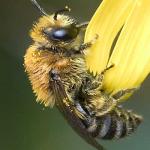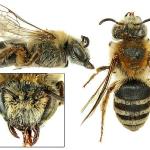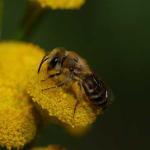Throughout much of southern Britain, from the Isles of Scilly to Kent, and northwards to Lancashire, South-east Yorkshire and the Isle of Man. In Wales, known from West Glamorgan and Pembrokeshire. Apparently reported in the Channel Islands only from Alderney (Luff 1900, Saunders 1902). In Ireland it is widespread, though mainly coastal, from Louth to Waterford. There are no records from Scotland. Usually found only in small numbers in most localities, though it is often very common on the sand dune systems of south-east Ireland (pers. obs.). Widespread in the Palaearctic, the range encompassing southern Sweden to Greece, Spain to Siberia, the Middle East, north Africa (Morocco and Algeria) and Asia Minor.
This species is not regarded as being scarce or threatened.
Whereas most British Colletes have a distinct preference for light sandy soils, this bee is more catholic in its choice, being found on chalk grassland, heaths, moors, sand pits, open woodland as well as on coastal cliffs and dunes. On the south-east coast of Ireland, the species flies with Colletes floralis, the two often visiting the same flowers.
Univoltine; mid June to mid September.
Often occurs in small nesting aggregations consisting of only a few closely scattered burrows, generally in level soil. A nest has been illustrated by Westrich (1989).
Wild mignonette (Reseda lutea), dropwort (Filipendula vulgaris), wild angelica (Angelica sylvestris), hogweed (Heracleum sphondylium), wild carrot (Daucus carota), white bryony (Bryonia dioica), spurge (Euphorbia species), sheep's-bit (Jasione montana), ragwort (Senecio species), fleabane (Inula and Pulicaria species), yarrow (Achillea species), tansy (Tanacetum vulgare), cat's-ear (Hypochaeris species), autumn hawkbit (Leontodon autumnalis), creeping thistle (Cirsium arvense), milk thistle (Silybum marianum) and sow-thistle (Sonchus species).
Epeolus variegatus (R C L Perkins 1923, Richards 1937).




